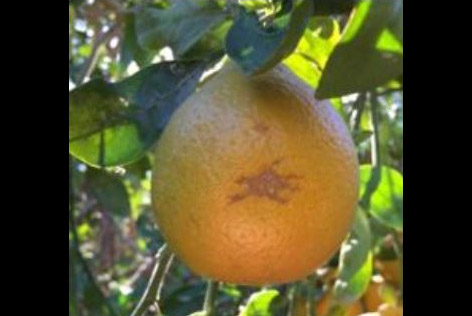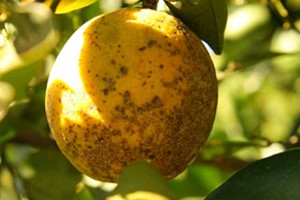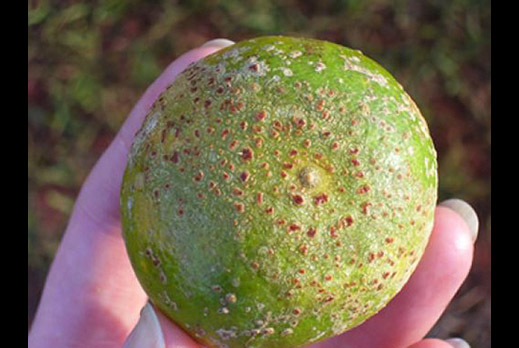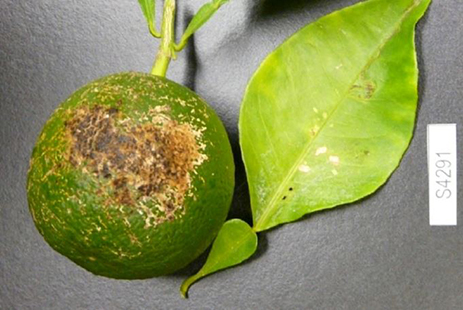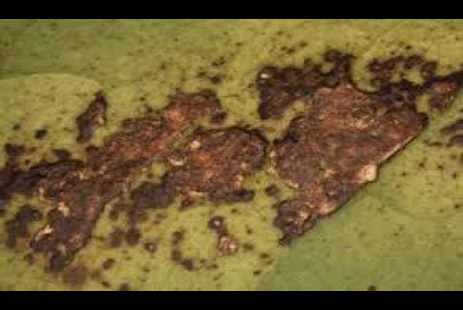Sweet Orange Scab Pest Profile
Pest Profile
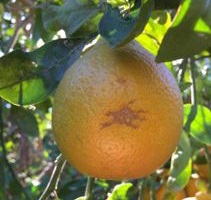
Photo credit: Heather Scheck, CDFA
Description
Sweet orange scab (SOS) is a plant disease caused by the fungal pathogen Elsinöe australis, which results in the formation of pustules (small raised spots or rounded swelling) and lesions on the skin or rind of citrus fruit.
History
Two scab diseases on citrus are now common in many humid citrus growing areas worldwide: sour citrus scab, caused by Elsinoë fawcettii, and sweet orange scab (SOS), caused by E. australis. Multiple pathotypes have been identified for both species. Sour citrus scab has already been widely distributed around the world, whereas sweet orange scab was limited mostly to southern South America, until it was detected in the United States for the first time in Texas in 2010 in residential lemon and tangerine trees.
Distribution
SOS is a common disease in South America, mainly Brazil, Argentina, and Paraguay. SOS has now been confirmed in Louisiana, Florida, Arizona, Alabama, California, Mississippi, Puerto Rico, and Texas. Beginning in 2013, SOS has been found in portions of California in the Calipatria and Winterhaven areas of Imperial County, in Pomona in Los Angeles and San Bernardino counties, in North Tustin in Orange County, and in the Riverside and Blythe areas of Riverside County.
Symptoms
The initial scab or lesion forms on very young fruit, is slightly raised, and pink to light brown in color. As the lesion expands, it appears cracked or warty and may change color to yellowish brown, and eventually to dark gray. The scabs typically form a pattern on the fruit that resembles water splashes. The central area of the fungal growth is depressed and becomes drab, greyish, and velvety, when the pathogen is producing spores. Old scab lesions have a rough surface, are dusk colored, and become cracked and fissured. Fruits are infected in the early stages of their development, grow misshapen, and are subject to premature drop. On the rind of developed fruits, raised lesions are formed with different shapes, sizes, and colors depending on citrus species and cultivar affected. These lesions can appear as scattered protuberances, conical projections, craters, extensive areas of fine eruptions, or they can coalesce to give scabby patches.
Similar warty lesions and corky eruptions are formed on young twigs, shoots, and stems of nursery plants, which can grow bushy and stunted. On young stems, the lesions resemble an area of dieback that has been scabbed over. Lesions begin on the underside of leaves as water-soaked spots and typically form along the edge of the leaf or the mid-vein.
USDA flickr album of SOS:
https://www.flickr.com/photos/usdagov/sets/72157717245392167/
Hosts
Hosts for Elsinöe australis include the fruit and propagative parts of all Citrus and Fortunella species and hybrids, plus Simmondsia chinensis (jojoba). The most susceptible hosts are sweet orange and tangerine.
Damage and Economic Importance
Although there is minimal effect on internal fruit quality and taste, fruit afflicted with SOS can be severely blemished, rendering them unfit for sale in the fresh produce market and subject to export quarantines. Additionally, the disease can cause premature fruit drop and stunt young nursery trees and new field plantings. SOS presents a real and ongoing threat to California’s commercial and residential citrus. Physical movement of infected host fruit is a recognized channel for the spread of SOS from an established area to a new location. Spores may also be spread by wind and rain dispersal. Fruit from regulated areas must be washed, brushed, disinfested, treated, and waxed prior to shipment to help prevent the spread of this fungal pathogen.
SOS is an actionable, quarantine pest in California and under a Federal Quarantine Order DA-2016-55.

